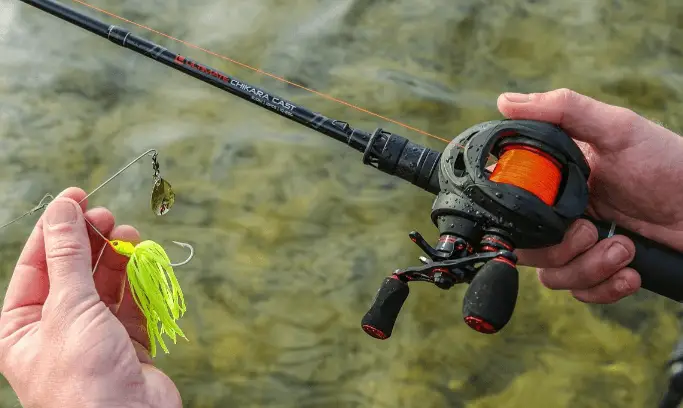In this guide we share about How to Cast a Baitcaster Reel so let’s start –
To cast a baitcaster reel, align the reel properly and use your thumb to control the spool’s speed. Practice thumb pressure to master the casting technique and minimize backlashes.
Cast a baitcaster reel with precision is a skill that enhances your fishing experience. This method offers better control and accuracy, appealing to anglers who target specific locations in the water. Learning to maneuver a baitcaster involves understanding the tension knob, braking system, and the pivotal role of thumb control.
Mastery of this technique not only increases your catch rate but also reduces the likelihood of line tangles and the frustration that comes with it. Aspiring and seasoned fishermen alike can benefit from mastering the art of baitcaster casting, which, once achieved, opens the door to a more professional and satisfying fishing venture. Whether targeting bass in freshwater or aiming for inshore species, the baitcaster reel is a valuable tool in your angling arsenal.
Essentials Of Baitcasting
Mastering the art of baitcasting takes practice and patience. Let’s unravel the basics for beginners eager to join the baitcaster club. Baitcasting involves precision and control, handling the line with finesse. It all starts with understanding your equipment.
Types Of Baitcaster Reels
Selecting the right type of baitcaster reel is crucial for a successful fishing trip. Let’s explore the common variants:
1. Round Baitcaster Reels : Ideal for heavier lines and longer casts.
2. Low-Profile Baitcaster Reels: Designed for comfort, easier to palm, and great for lighter lines.
Choose based on the fish you’re targeting and your preferred fishing style.
Advantages Of Using A Baitcaster
Baitcasting reels empower you with several benefits:
1. Better Line Control: Precisely place your lure where fish are hiding.
2. Increased Power: Handle bigger fish with greater torque.
3. Accuracy: Target specific areas with fewer snags.
Incorporate a baitcaster for a more rewarding fishing experience.
Setting Up Your Gear
Before you start casting, a proper gear setup is vital. This setup includes the right rod, spooled line, and attached reel. Let’s dive into the essentials.
Choosing The Right Rod
Choosing a compatible rod for your baitcaster is crucial for an optimal fishing experience. Look for rods that specifically state they are baitcasting models. The length of the rod should match your fishing style — shorter rods offer better accuracy for close casts, while longer rods are great for distance.
Spooling The Line For Cast a baitcaster
Correct spooling of the line ensures smooth casts and fewer tangles. Here’s a simple process:
- Open the baitcaster’s front cover to access the spool.
- Run the line through the rod’s guides.
- Attach the line to the spool with an arbor knot.
- Apply slight tension and wind the line onto the spool evenly.
Attaching The Reel To The Rod
Now, it’s time to combine both major components.
- Align the reel foot with the rod’s reel seat.
- Insert the foot into the seat, and tighten the clamps.
- Ensure the reel is secured firmly with no wobble.
With these steps followed, your baitcaster reel is ready for action. Proper setup leads to successful casts!
Adjusting The Baitcaster
Mastering the art of casting with a baitcaster reel takes precision. One crucial step, adjusting the baitcaster, is key to a smooth and controlled cast every time.
Tuning The Drag System
Getting the drag system right is essential for managing the line’s resistance when a fish strikes. Begin by:
- Turning the drag knob, found on the reel’s cap. A right spin tightens; left loosens.
- Set it just tight enough to avoid line overruns, without snapping the line.
- Check by pulling the line with a steady hand; it should release with some resistance.
Dial-in to the perfect drag setting to match the fishing conditions and the target species.
Setting The Brake And Tension
The brake and tension knobs on a baitcaster control the spool speed and help prevent tangles. Here’s how to set them:
- Locate the brake system on the side of the reel. It may click as it adjusts.
- Begin with a higher setting and reduce incrementally until finding the sweet spot.
- Adjust the tension knob next to the reel handle to control the spool’s resistance.
- A proper setting lets the lure fall slowly and smoothly when released.
Test these adjustments with practice casts, tuning as needed for optimal performance.
With these components finely adjusted, your baitcaster reel is ready to deliver top-tier performance that will surely enhance your fishing experience.
Baitcaster Casting Techniques
Mastering the art of casting is crucial for every angler. The right casting technique ensures precision. It helps you place your bait exactly where the fish are. Whether you’re a beginner or looking to refine your skills, these casting methods will enhance your fishing game. Let’s dive into the basics of casting a baitcaster reel. Remember to practice these techniques. They become second nature with time. Sharpen your casting skills and you’ll see a notable difference in your catches!
Basic Casting Motion
The basic casting motion is the foundation for all casting techniques. To perform it:
- Stand with your feet shoulder-width apart.
- Grip the rod securely with your dominant hand.
- Unlock the reel spool with your thumb.
- Swing the rod tip behind you, then smoothly forward.
- Release your thumb from the spool as the rod comes forward.
- Stop the spool with your thumb to drop the bait at your target.
Practicing this motion builds muscle memory. It leads to more accurate casts.
The Overhand Cast
The Overhand Cast excels in distance and control.
- Raise the rod above your head and behind you.
- Cast the line forward in a quick, straight motion.
- Thumb controls the spool as the line releases.
- Timing is key, release the thumb at the peak of your forward motion.
This technique suits open areas with minimal obstacles. It helps cast long distances.
The Sidearm Cast
The Sidearm Cast is perfect for tight spaces.
- Stand parallel to your target zone.
- Hold the rod horizontally to the water surface.
- Swing the rod side to side, releasing the line sideways.
- Control the spool with your thumb to avoid backlash.
Use this cast around docks or under trees. It allows for precision under obstacles.
Pitching And Flipping
Pitching and Flipping are finesse techniques for short-range casting.
- For Pitching:
- Extend your arm and hold the rod horizontally.
- Pull the line with the free hand to create tension.
- Snap the rod tip forward gently, releasing the line to the target.
- For Flipping:
- Keep the line short and use your wrist to flick the bait towards the target.
- Less about the cast, more about placing the bait quietly.
- Excellent for sneaky, close-quarter fishing.
Flipping is silent and effective in spooky waters. Pitching offers more distance.
Perfecting these casting techniques takes patience and practice. Start with the Basic Casting Motion to lay your foundation. Progress to the Overhand and Sidearm Casts for diverse situations. For stealthy, close-up action, Pitching and Flipping are your go-to moves. Equip yourself with these skills and watch your fishing efficiency soar!
Troubleshooting Common Issues
Mastering a baitcaster reel brings precision to casting and enhances fishing performance. But even the most skilled anglers encounter snags and snarls. Let’s troubleshoot the common hurdles, keeping your angling adventures smooth and enjoyable.
Dealing With Backlashes
A backlash is the dreaded “bird’s nest” of tangled line on a baitcaster. It’s caused when the spool spins faster than the line is leaving the reel. Here’s how to fix backlashes:
- Stop the reel as soon as a backlash occurs to prevent further tangling.
- Gently pull the line above the backlash to tease out loose loops.
- Use a pointed object like a toothpick to loosen tightly bound loops.
- Be patient; rushing can worsen the tangle.
Resolving Line Twists
Line twists reduce casting accuracy and can lead to weaker lines. Prevent and fix them with these steps:
- Check for proper spooling; the line should come off the spool the same way it goes on the reel.
- Cast and retrieve slowly to minimize twisting.
- If twists occur, detach the lure, let out line with the current, and reel back in.
Maintaining Your Baitcaster Reel
Maintenance keeps a baitcaster performing well. Regular care avoids common issues:
| Frequency | Maintenance Task |
| After each use | Wipe down the reel with a soft cloth. |
| Monthly | Apply oil to the spool bearings. |
| Every six months | Clean and lubricate the gear mechanism. |
Routinely check for any loose screws or parts and tighten them. Store your reel in a cool, dry place to protect it from the elements.
Advanced Strategies
Mastering the art of baitcaster reel usage elevates your fishing game. This section delves into techniques for experienced anglers seeking to push their capabilities. Let’s unlock the potential of your baitcaster for peak performance.
Casting For Distance
Optimizing reel settings is key to achieving long-distance casts.
- Choose the right rod: A longer rod launches baits farther.
- Tweak the brakes: Minimize friction, maximize flight.
- Optimal spool tension: Enables smoother line release.
- Use appropriate line: Heavier lines cast further.
- Wind direction: Cast with the wind, not against.
Accuracy Techniques
Accurate casting ensures effective lure placements.
| Technique | How to Execute |
| Thumb Control | Apply varying pressure during cast for precision. |
| Pitching and Flipping | Short, controlled casts for tight spots. |
| Target Practice | Consistently aim for specific areas to improve skill. |
Frequently Asked Questions Of How To Cast A Baitcaster Reel
What Is A Baitcaster Reel?
A Baitcaster reel is a type of fishing reel with a revolving spool that sits atop a casting rod with a trigger handle. It’s known for greater accuracy in casting and is favored by experienced anglers for its control and proficiency with a variety of lures.
How Do You Spool A Baitcaster?
To spool a Baitcaster, first attach the reel to the rod, run the line through the guides, and tie it to the spool. Apply light tension to the line with your fingers as you slowly reel in, ensuring the line lays evenly across the spool without any twists.
What Are The Baitcasting Techniques?
Baitcasting techniques include the overhand cast, sidearm cast, and pitching. These methods involve controlling the spool’s speed to prevent tangles, coupled with accurately directing the lure to the desired location by utilizing wrist and forearm movements.
Final Word
Mastering the art of baitcaster reel casting might seem daunting at first. Yet with practice, it becomes second nature. Embrace these tips to enhance your angling skills and enjoy the precision that baitcasters offer. So grab your gear, hit the water, and cast into your next fishing adventure with confidence. I hope you enjoy the article about on how to cast a baitcaster reel .
Happy fishing!


